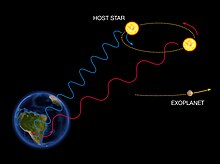
Back تحليل دوبلر الطيفي Arabic Метад Доплера Byelorussian Espectroscòpia Doppler Catalan Espectroscopia Doppler Spanish طیفسنجی داپلر Persian Säteisnopeusmenetelmä Finnish Méthode des vitesses radiales French Spettroscopia Doppler Italian ドップラー分光法 Japanese 도플러 분광학 Korean


Doppler spectroscopy (also known as the radial-velocity method, or colloquially, the wobble method) is an indirect method for finding extrasolar planets and brown dwarfs from radial-velocity measurements via observation of Doppler shifts in the spectrum of the planet's parent star. As of November 2022, about 19.5% of known extrasolar planets (1,018 of the total) have been discovered using Doppler spectroscopy.[2]
- ^ Wenz, John (10 October 2019). "Lessons from scorching hot weirdo-planets". Knowable Magazine. Annual Reviews. doi:10.1146/knowable-101019-2. Retrieved 4 April 2022.
- ^ "Exoplanet and Candidate Statistics". NASA Exoplanet Archive. NASA Exoplanet Science Institute. Retrieved 27 November 2022.
© MMXXIII Rich X Search. We shall prevail. All rights reserved. Rich X Search